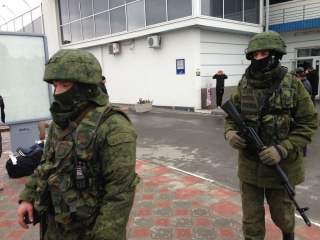Limited War Is Back
NATO's current strategic framework might fail to deter further gains by Russia's green men.
These impressions and tendencies can ultimately only be countered by having and implementing a workable strategy. NATO’s Strategic Concept has ceased to carry the credibility for playing such a role. Washington can begin to address this problem by producing an umbrella concept that outlines the seriousness of new threats like limited war, states its resolve for countering them, and explains how U.S. and allied capabilities could plausibly be employed in tandem to ensure continued stability. Allies need to understand, in unambiguous terms, that while we may be cutting back, we also have a strategy for reshaping the U.S. military at a doctrinal and technological level that sustains stability in their region. It needs to be clear to them that the success of this strategy requires local defense on their part. An implicit bargain would include U.S. investments in upper-tier capabilities like naval, air and nuclear assets paired with local investments in conventional land power sufficiently robust to create local “no-go” zones until U.S. forces arrive. Such a bargain would need to be buttressed by the physical presence of American assets and manpower—small garrisons at the frontier to show U.S. commitment and make the use of its more mobile and lethal power credible.
Most importantly, the United States needs to figure out how to create the right incentives for allies to invest in local defense. It is one thing to tell states to do more for their own defense, as recent U.S. secretaries of defense have done again and again, and another to give them real incentives to create robust indigenous militaries and avoid free riding. It’s not enough for states to be exposed to a threat, as advocates of “offshore balancing” have long argued; they must also know that they have a reasonable chance of success in pursuing the option of resistance. If NATO is going to persist in its current split into two tiers of the serious and the unserious, we might as well stack the incentives to make the former behavior profitable—and be explicit about it. Article 5 of the North Atlantic Treaty should remain the life insurance of a NATO country’s security relationship with the United States—a safety net in the event of a catastrophic, full-scale assault on a member of the alliance. But, as we observed, Article 5, and the American extended deterrent that underpins it, is less credible and effective when dealing with a quick and limited incursion. Hence, the United States should devise a “matching” strategy—a kind of geopolitical 401(k): for those allies that spend a certain amount on local defense, we will “match” their efforts in the form of commitments or agreements over and above our commitment to extended deterrence under Article 5. This could be broadened at an alliance level, if member politics allow, to create a new clause in which the alliance’s four largest economies agree to match the defense contributions of its four most geopolitically exposed members (e.g., Poland and the Baltic states) on some basis, whether through defense subsidies, technology sharing, access to sensitive weapons or troop contributions.
The “matching” approach increases the risk for those states that decide not to shore up their defenses. But, unlike a U.S. retrenchment that abandons allies to a more dangerous scenario, it also establishes clear rewards for those who decide to contribute in a meaningful way to their own security. An increased risk alone may tilt some frontier states toward the revisionist neighbor, Russia; the possibility of a reward restores the balance and gives a clear alternative to the local leaders. Further steps could include the offer of rebated surplus U.S. military equipment (artillery, tanks and fighters) to eastern NATO members, the creation of light frontier forces to give the Baltic states time to mobilize in the event of a crisis, and—over time—the creation of Swiss-style self-defense doctrines among exposed allies that would deter Russian aggression by driving up the costs of conflict at the local level.
Ultimately, the war in Ukraine demonstrates that NATO must find an effective way to deal with the revived threat of limited war. The West faces similar tactics from China in the South China Sea. Whatever form it takes, the key is to shift the focus from extended deterrence as a solution to all the alliance’s security needs to a preclusive-defense mind-set that raises the costs of limited war, mainly by incentivizing increased investments in local defense. Such an approach would prioritize the strategic resilience and survivability of NATO’s frontline states as the ultimate determinant of the alliance’s survival. It would explicitly seek to alleviate these states’ reemerging security dilemmas by both their own and other members’ contributions in the full spirit of the North Atlantic Treaty while shifting intra-NATO requirements to match a profoundly altered threat landscape. Doing so would help to support the creation of a new defense posture that, while difficult to imagine in its details now, is indispensable for ensuring the relevance and survival of NATO in a new and in many ways more dangerous era.
Jakub Grygiel is the George H. W. Bush Associate Professor of International Relations at Johns Hopkins University’s School of Advanced International Studies. A. Wess Mitchell is president of the Center for European Policy Analysis.

